The vibrancy of colors is something that brings in a lot of positivity in our lives and Holi being the festival of colours is actually a day worth rejoicing. Holi is a famous Hindu festival that is celebrated in every part of India with utmost joy and enthusiasm. The ritual starts by lighting up the bonfire one day before the day of Holi and this process symbolizes the triumph of good over the bad. On the day of Holi people play with colours with their friends and families and in evening they show love and respect to their close ones with Abeer.
Different Types of Holi In India
India is a land of disparity; it is exciting to know about how do people celebrate Holi differently across the country. Some famous types of Holi in India are Lathmar Holi, Dol Jatra, Phaguwa, Rang Panchmi/Shigmo, Yaosang, Baithaki/Khadi, Manjal Kuli/Ukuli, Basant Utsav and Dola.
Lathmar Holi

Lathmar Holi Festival is one of the unique and famous ways of Holi celebration in Uttar Pradesh province in India. Lathmar Holi of Barsana is primarily celebrated in the native place of Lord Krishna. All the natives of the area of Vrindavan, Mathura, Nandgoan, and Barsana come together to celebrate Holi with Lathis (Sticks) and colors made up of Kesudo and Palash flowers. As per tradition, Gops (men) of Barsana try to invade in Nandgaon to play Holi with Gopis (women). In reciprocation, Gopis beat the Gops (men) with the sticks to pervert themselves to get colored. Isn’t that fun to watch and take part in it!! People from all over the world come for Lathmar Holi in Mathura every year. Shouldn’t Lathmar Holi 2023 be in the checklist!!
Dola
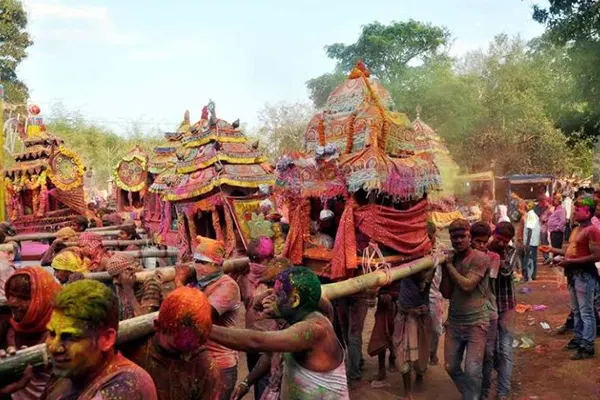 r
rDola Holi is celebrated among the coastal region of Odisha province of India. Dola Holi Celebration lasts for five-seven days, unlike two days, in the rest of India. Dola celebration starts on Falgun Dashmi (date as per Hindu calendar) when all people take out Yatra (religious gathering) of their deities (especially Lord Krishna) and offering them Bhog (sweets) and Abira (colored powder). This yatra continues for the next four days and ends on Falgun Purnima (date as per Hindu calendar) by playing Holi. Isn’t that a good idea to participate in Dola and celebrate Holi for five days in a row?
Phagunwa
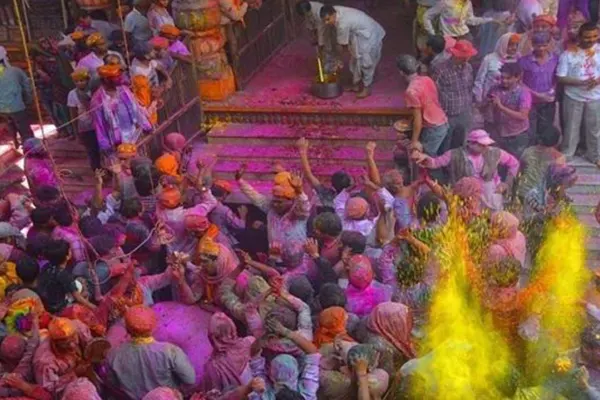
Phagunwa is the celebration of Holi in the local dialect Bhojpuri of the Bihar province of India. Phagunwa Holi is celebrated with the folk songs, Thandai and Gunjiyas and never-ending fun with family and friends. Why don’t you plan to Holi Celebration 2023 in the Desi style of Phagunwa?
Basant Utsav

Basant Utsav is the celebration of Holi in the West Bengal region of India. People welcome Basant Ritu (spring season) with open arms in West Bengal. They dress in yellow during Basant Utsav and play Holi with Gulaal (colored powder) for the whole day. Also, the Dola is a significant part of the Holi celebration in Bengal. Dola Yatra (religious gathering) is taken out on the main day where people play colors with squirt and Abira (colored powder) along with the procession. It is a sight full of bliss, enjoyment, and happiness. Book the tickets for India to celebrate Basant Utsav, Holi in 2023.
Shigmo
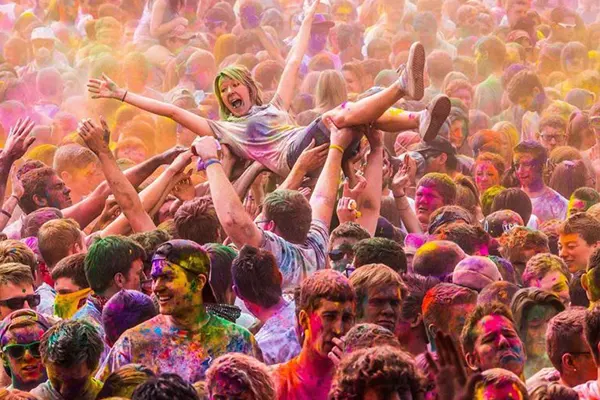
Shigmo Holi is a form of Holi celebration in the Indian state of Goa. It is one of the major festivals of farmers as they welcome spring delightfully. Shigmo Utsava is celebrated for 14 days with splendor every year. Shigmo is one of the traditional festivals of Goa, which is very different from other local carnivals of Goa. Just imagine the fun of Holi on the coasts of Goa. It’s an experience, worth giving a shot!
Yoasang
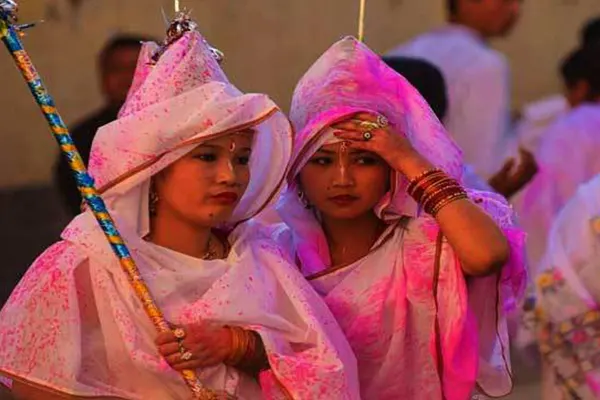
Yoasangis the Holi festival celebrated on the last full moon day of Lamda in Manipur province of India. This lasts for six days. The entire valley covered in festive colors during those days. The youth takes part in this by constructing bamboo huts on the roadside called ‘Yaosang’. An idol of Lord Chaitanya is placed in the hut by a Brahmin (Devotee). Puja is offered and bhajans and kirtans are chanted. On the last day, the idols are removed and the hut is set on fire with the chanting of ‘Hari Bola’ and ‘He Hari’. The Holi is played in the Govindjee temple, colors are mixed in the wells and then sprayed on the people who dance in the beats of the devotional songs in praise of Lord Krishna.
Baithaki or Khadi Holi
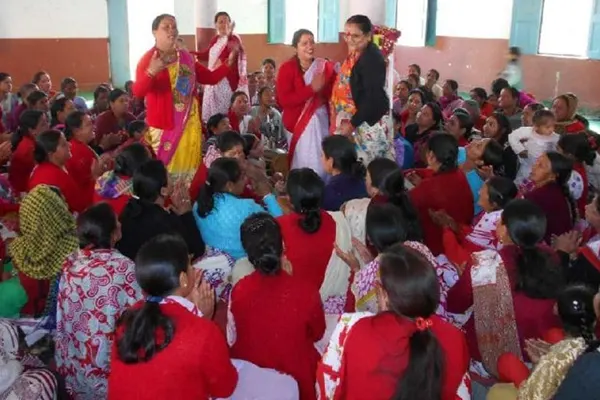
In Uttrakhand, Holi is celebrated as Baithaki or Khadi Holi, people gather in their traditional attire, singing traditional songs and roam around in the city in Toils. People wish each other by smearing colors on their faces. Holi is a festival of colors and frolic in Uttrakhand.
Rang Panchami
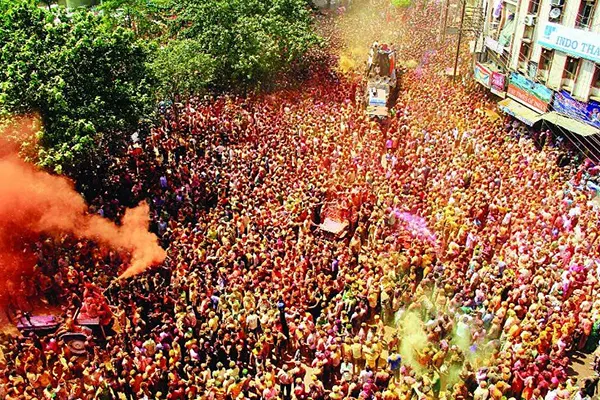
In Maharashtra, Holi is also known as Rang Panchmi. The celebration starts by lighting a pyre of firewood known as Holika Dahan. The next day, people play with dry and wet colors twirling on the beats of music.
Dol Jatra
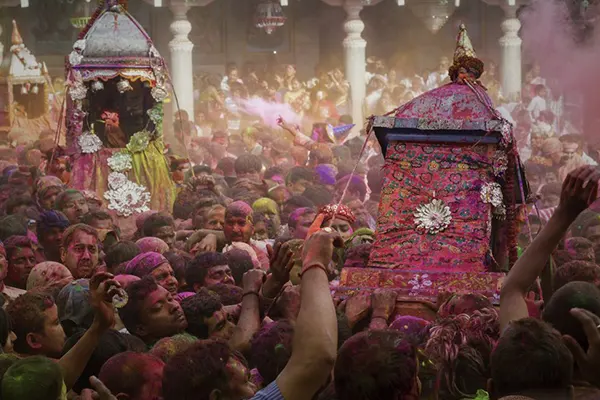
The land of Roshagulla, West Bengal also has a very sweet way of celebrating the phenomenal festival of Holi. Holi is here known as Basant Utsava or Dol Jatra. Women here dress in yellow, a color that signifies abundance and celebrates the rich Bengali culture with colors and music. In addition, there is also a recital of the poetry of Rabindranath Tagore with traditional songs and dance. The day after Holi is celebrated as Dol Jatra, a humongous procession of Lord Krishna taken through the streets accompanied by singing and dancing revelers.
Manjal Kuli or Ukuli

In Kerala, Holi is celebrated as Manjal Kuli, also known as Ukuli. The Kumba and Konkani communities of Kerala have their own unique way of celebrating Holi. Turmeric or Manjal Kuli is mainly used as color to play Holi.
Pakuwah
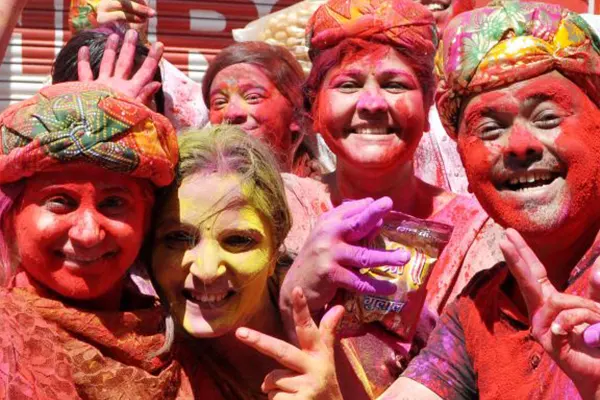
Pakuwah is the native celebration of Holi in Assam. It is quite similar to the Dol Jatra and you will find many common elements in the celebration alike West Bengal. Pakuwah is celebrated for two days. On the first day, people burn the clay hut to celebrate the victory of good followed by the second day’s celebration with colors.
Hola Mohalla
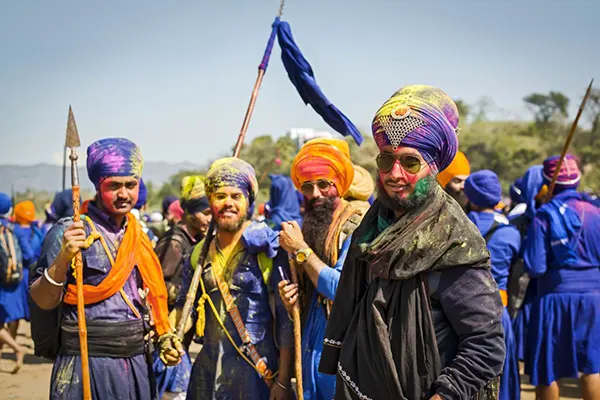
Famously known as the Holi of the warrior is celebrated by the Nihang Sikhs in Punjab. This is very unique and out of the box celebration of Holi. A day before Holi people exhibit martial arts, sing and dance their hearts out.
History of Holi
Holi is an ancient festival of India and was originally known as ‘Holika’. The festivals finds a detailed description in early religious works such as Jaimini’s Purvamimamsa-Sutras and Kathaka-Grhya-Sutras. Historians also believe that Holi was celebrated by all Aryans but more so in the Eastern part of India.
It is said that Holi existed several centuries before Christ. However, the meaning of the festival is believed to have changed over the years. Earlier it was a special rite performed by married women for the happiness and well-being of their families and the full moon (Raka) was worshiped.
Calculating the Day of Holi
There are two ways of reckoning a lunar month- ‘purnimanta’ and ‘amanta’. In the former, the first day starts after the full moon; and in the latter, after the new moon. Though the amanta reckoning is more common now, the purnimanta was very much in vogue in the earlier days.
According to this purnimanta reckoning, Phalguna purnima was the last day of the year and the new year heralding the Vasanta-ritu (with spring starting from next day). Thus the full moon festival of Holika gradually became a festival of merrymaking, announcing the commencement of the spring season. This perhaps explains the other names of this festival – Vasanta-Mahotsava and Kama-Mahotsava.
Reference in Ancient Texts and InscriptionsBesides having a detailed description in the Vedas and Puranas such as Narad Purana and Bhavishya Purana, the festival of Holi finds a mention in Jaimini Mimansa. A stone incription belonging to 300 BC found at Ramgarh in the province of Vindhya has mention of Holikotsav on it. King Harsha, too has mentioned about holikotsav in his work Ratnavali that was written during the 7th century.
The famous Muslim tourist – Ulbaruni too has mentioned about holikotsav in his historical memories. Other Muslim writers of that period have mentioned, that holikotsav were not only celebrated by the Hindus but also by the Muslims.
Reference in Ancient Paintings and Murals
The festival of Holi also finds a reference in the sculptures on walls of old temples. A 16th century panel sculpted in a temple at Hampi, capital of Vijayanagar, shows a joyous scene of Holi. The painting depicts a Prince and his Princess standing amidst maids waiting with syringes or pichkaris to drench the Royal couple in coloured water.
A 16th century Ahmednagar painting is on the theme of Vasanta Ragini – spring song or music. It shows a royal couple sitting on a grand swing, while maidens are playing music and spraying colors with pichkaris.
Legends and Mythology
In some parts of India, specially in Bengal and Orissa, Holi Purnima is also celebrated as the birthday of Shri Chaitanya Mahaprabhu (A.D. 1486-1533). However, the literal meaning of the word ‘Holi’ is ‘burning’. There are various legends to explain the meaning of this word, most prominent of all is the legend associated with demon king Hiranyakashyap.
Hiranyakashyap wanted everybody in his kingdom to worship only him but to his great disappointment, his son, Prahlad became an ardent devotee of Lord Naarayana. Hiaranyakashyap commanded his sister, Holika to enter a blazing fire with Prahlad in her lap. Holika had a boon whereby she could enter fire without any damage on herself. However, she was not aware that the boon worked only when she enters the fire alone. As a result she paid a price for her sinister desires, while Prahlad was saved by the grace of the god for his extreme devotion. The festival, therefore, celebrates the victory of good over evil and also the triumph of devotion.
There are also a few other legends associated with the festival – like the legend of Shiva and Kaamadeva and those of Ogress Dhundhi and Pootana. All depict triumph of good over evil – lending a philosophy to the festival.
Holi Celebration
Holi celebration takes place with lot of joy and verve throughout the country. The enthusiasm of the people reaches its peak and matches with the nature which is in full bounty at the time of Holi.
Holi is being celebrated in Indian since time immemorial but the popularity of Holi celebrations seems to be rising with every passing year and so is the level of hoo-ha. As no other festival gives so much liberty to the people to let their hair loose and enjoy their hidden crazy self.
Differences of any sort are drowned in the coloured waters of Holi and people just enjoy being a play animal. To further enhance the festive spirit of Holi celebrations we have a social sanction to get a kick with the tradition of bhang. Then there is total wildness as people dance to the rhythm of dholak and sing traditional folk songs in loudest possible pitch.
Children particularly enjoy the festival as they throw water filled balloons at passersby…and if anybody stares..they have ready answer, ‘Bura na mano Holi hai..’ and evoke a smile on the irritated face. Besides, they have their water missiles, called pichkaris to drench the person from far and escape further drenching.
In the midst of these colouring games are savoured the mouth watering holi specialities like gujiya, malpuas, mathri, puran poli, dahi badas etc and downed with glasses full of thandai.
In some states there is also a tradition of breaking the pot full of buttermilk which is hung high on the streets. A group of boys form a human pyramid and one of them break the pot. All this while womenfolk throw buckets of colour water on them and sing folk songs.
And after a wild and eventful day, evenings are celebrated in a dignified manner by visiting friends and relatives. People exchange sweets and hug each other conveying the warm wishes for Holi. These days there people also participate and organise Holi Meets and enjoy the festival till late in the night.
Holi celebrations that starts with the burning of Holika on the eve of Holi thus culminates with the lot of funfilled activity and bonhomie. However, at some places specially Mathura and Barsana Holi celebrations continue for a week as each major temple organise a Holi bash on different day. Lovers of the festival enjoy every moment to the hilt.
Rituals of Holi
Rituals of the ancient festival of Holi are religiously followed every year with care and enthusiasm.
PreparationsDays before the festival people start gathering wood for the lighting of the bonfire called Holika at the major crossroads of the city. This ensures that at the time of the actual celebration a huge pile of wood is collected.
Holika Dahan CelebrationsThen on the eve of Holi, Holika Dahan takes place. Effigy of Holika, the devil minded sister of demon King Hiranyakashyap is placed in the wood and burnt. For, Holika tried to kill Hiranyakashyap’s son Prahlad, an ardent devotee of Lord Naarayana. The ritual symbolises the victory of good over evil and also the triumph of a true devotee.
Children also hurl abuses at Holika and pray pranks, as if they still try to chase away Dhundhi who once troubled little ones in the Kingdom of Prithu. Some people also take embers from the fire to their homes to rekindle their own domestic fires.
Play of ColorsNext day, is of course the main day of Holi celebrations. The day is called Dhuleti and it is on this day that the actual play of colours take place. There is no tradition of holding puja and is meant for pure enjoyment.
The tradition of playing colours is particularly rampant in north India and even in that region, there can be no comparison to the Holi of Mathura and Vrindavan. In Maharashtra and Gujarat too Holi is celebrated with lot of enthusiasm and fun.
People take extreme delight in spraying colour water on each other with pichkaris or pouring buckets and buckets of it. Singing Bollywood Holi numbers and dancing on the beat of dholak is also a part of the tradition. Amidst all this activity people relish gujiya, mathri, malpuas and other traditional Holi delicacies with great joy.
Drinks, specially thandai laced with bhang is also an intrinsic part of the Holi festivity. Bhang helps to further enhance the spirit of the occasion but if taken in excess it might dampen it also. So caution should be taken while consuming it.
Holi Celebrations in South IndiaIn south India, however, people follow the tradition of worshiping Kaamadeva, the love god of Indian mythology. People have faith in the legend which speak about the great sacrifice of Kaamadeva when he shot his love arrow on Lord Shiva to break his meditation and evoke his interest in worldly affairs.
After, an eventful and funfilled day people become a little sober in the evening and greet friends and relatives by visiting them and exchange sweets. Holi special get togethers are also organised by various cultural organisations to generate harmony and brotherhood in the society.
The Evening of Bonfires
Holika Dahan or the lighting of bonfire takes place on the eve of Holi. The day is also popularly called ‘Chhoti Holi’ or the ‘Small Holi’.The bigger event – play with the colour takes place on the next ‘big’ day.
Holika Dahan is an extremely popular tradition and is celebrated with fervour all across the country and is symbolic of triumph of good over evil. There are numerous legends associated with this ancient tradition and it is difficult to pin-point as to when actually the tradition started.
A Brief HistoryHolikotsav finds a mention in the Vedas and Puranas. It is stated that during the Vedic period the sacred fire of Holi was burnt amidst the chanting of specific mantras which were intended for the destruction of the demonic forces. It is also said that on this very day Vaishwadev oblation commenced in which offerings of wheat, gram and oat were made to the sacrificial fire.
Some scholars believe that Holikotsav is named after fried cereals or parched grains called ‘Holka’ in Sanskrit. These parched grains were used to perform hawana (a fire ritual).The vibhuti (sacred ashes) obtained from this ritual was smeared on the forehead of those who participated in the ritual to keep away evil. This vibhuti is called Bhumi Hari. Till date there is a tradition of offering wheat and oat into the Holika fire.
According to Narad Purana, this day is celebrated in the memory of Prahlad’s victory and the defeat of his aunt ‘Holika’. The legend has it that there once existed a mighty demon king by the name of Hiranyakashyap who wished that everybody in his kingdom should worship him. His son, Prahlad became a follower of Lord Naarayana. Hiranyakashyap instructed his sister, Holika to sit in the burning fire with Prahlad in lap. She was blessed with a boon, as a result of which no fire could burn her. But the opposite happened, Prahlad survived and Holika was charred to death. Thus ‘holi’ is celebrated to commemorate the victory of virtue over evil.
It is because of this event, Holika (a bonfire) is burnt every year on Holi. The burning of the effigy of Holika is called Holika Dahan.
Another legend mentioned in the ‘Bhavishya Purana’ is also considered to be related to the festival of Holi. The legend goes back to the kingdom of Raghu, where lived an ogress called Dhundhi who used to trouble children but was finally chased away by them on the day of Holi. This is said to be the reason why the tradition of Holika Dahan is so popular amongst children and why they are allowed to play pranks on the day.
The Tradition
There is also a specific way in which Holika Dahan takes place. A log of wood is kept in a prominent public place on the Vasant Panchami day, almost 40 days before the Holi Festival. People go on throwing twigs, dried leaves, branches of trees left through the winter besides any other combustible material they can spare, on to that log which gradually grows into a sizable heap. On the day of Holika Dahan an effigy of Holika with child Prahlad in her lap is kept on the logs. Usually, Holika’s effigy is made of combustible materials, whereas, Prahlad’s effigy is made of non-combustible one. On the night of Phalguna Purnima, it is set alight amidst the chanting of Rakshoghna Mantras of the Rig Veda (4.4.1-15; 10.87.1-25 and so on) to ward off all evil spirits.
Next morning the ashes from the bonfire are collected as prasad and smeared on the limbs of the body. If spared by the fire coconuts are also collected and eaten.
Metaphorically though, the fire is meant to signify the destruction of evil – the burning of the ‘Holika’ – a mythological character and the triumph of good as symbolised by Prahlad. However, the heat from the fire also depicts that winter is behind and the hot summer days are ahead.
Next day after Holika Dahan is called Dhuleti, when play with colours actually takes place.
Samvatsar Dahan
It may be noted that in some places like Bihar and UP Holika Dahan is also known as ‘Samvatsar Dahan’. The concept of Samvatsar New Year varies in different provinces of our country. In some provinces the month commences from ‘Krishna Paksha’ while in others it commences from ‘Shukla Paksha’. For Krishna Paksha, the year ends on ‘Purnima’ of the month of Phalgun and thus the new year begins the next day – Chaitra, first day of the Krishna Paksha.
Tradition of Holi
The colourful festival of Holi is celebrated by different names in this vast and culturally diverse country. The traditions followed for the festival varies a little and at times a lot as one moves from one state to other studying the various facets of the festival and getting behind the various colours of it.
Nowhere it is celebrated with so much charm and enthusiasm as in Mathura, Vrindavan, Barsana and Nandgaon – the places associated with the birth and childhood of Lord Krishna. At Barsana Holi assumes the name of Lathmaar Holi. Here, women of Barsana give a tough time to men of Nandgaon as they come to play Holi with them. Women drag the unlucky captives, beat them, dress them in a female attire – yet all is in the spirit of Holi.
Women of Haryana, specifically the bhabhis too get an upper hand on the day as they get a social sanction to beat their devars and take a sweet revenge for all the mischiefs they have played on them. This revengeful tradition is called the Dulandi Holi.
The most enjoyable tradition of Holi, of course, apart from the play of colours is the tradition of breaking the pot. It is celebrated with much fan fair in the states of Maharashtra and Gujarat. Here a pot of buttermilk is hung high on the streets. Men form a huge human pyramid and one on the top breaks the pot with his head. All this while women keep singing Holi folk songs and throwing buckets and buckets of water. The tradition has its roots in the mischievous nature of Lord Krishna who was so fond of butter milk that he used to steal it from every accessible house in the village. To hide the butter from young Krishna, womenfolk used to hang it high. All in vain!
Holi is celebrated in the most dignified manner in the state of Bengal. At Vishwa Bharti University, founded by Rabindranath Tagore founded the tradition of celebrating Holi as ‘Basant Utsav’ or ‘Spring Festival’. Students decorate the campus with intricate rangolis and carry out prabhat pheris in the morning. Clad in a traditional attire young boys and girls sing songs composed by Gurudev and present an enchanting view to the onlookers who gather in large number here. In other parts of Bengal, Holi is celebrated as Dol Yatra where the idols of Radha and Krishna are placed on a decorated palanquin and taken out in a procession.
For Sikhs, Holi calls for the display of their physical strength and military prowess as they gather at Anandpur Sahib a day after Holi to celebrate Hola Mohalla. The tradition was started by the tenth and last guru of Sikh religion, Guru Gobind Singh ji and is being religiously carried forward.
In the north east, Manipuris celebrate the festival in a colourful manner for six continuous days. Here, the centuries old Yaosang Festival of Manipur amalgated with Holi with the introduction of Vaishnavism in the eighteenth century. The highlight of the festival here is a special Manipuri dance, called ‘Thabal Chongba’.
Well, there are many-many more ways in which Holi is celebrated. Different states, different cities and different villages have come out with their unique and innovative styles of playing Holi. It may not be possible to describe all of them at one place. What is noteworthy though is the fact that the spirit of Holi remains the same throughout. It is the festival which generates the spirit of brotherhood and bring people close – and this is what matters most than anything else.
What enhances the spirit of Holi though is the tradition of consuming the intoxicating bhang. It is generally consumed with thandai or as pakoras. People go high on it and enjoy the festival to the hilt. Other Holi delicacies include gujiya, mathri, malpua, puranpoli, dahi badas, etc. After a frenzied play of colours people love to gorge them up.
Festival of Colours
The festival of colours is Holi, it is vibrant and filled with beautiful colours. Holi is considered as one of major festival in India. It is celebrated in the month of Phalgun on full moon day according to Hindu calendar.
With the onset of spring, northern India gets into the colourful mood of Holi. This festival also denotes celebration due to good harvests and land fertility. This colourful festival also celebrates the eternal love of Radha and Krishna. This festival is celebrated in a grand style in the city of Mathura and Vrindavan. These are two important cities which are deeply associated to Lord Krishna.
The festival of colours teaches humankind to transcend above the caste and creed. It is a festival to forget old grievances and meeting others with great warmth & high spirit. This festival begins with lightening of bonfire on Holi eve. Next day, people play Holi with different types of colours, abirs and gulals. They greet each other with Shubh Holi i.e. Happy Holi and send warm wishes of the festival.
Kids and adults come out of their house and smear each other with bright shades of gulal. Colouful waters are sprinkled on people and kids are found playing with pichkari and water balloons. People exchange sweets, Thandai and snacks among neighbours and friends. Popular Holi sweets are Gujiya, Ladoo, Burfi and Imarti etc. Indian festive celebration is incomplete without delicious sweets.
People also dance in the beats of Holi songs and popular folka’s music. Exchange of holi gifts, snack hampers, dry fruits and greeting cards are also found.
Holi festival has religious and historical significance in Hindu texts. There was very popular mythological legend about king ‘Hiranyakashyapu’ and his son ‘Prahlad’. The devil king used to hate God esp. Lord Vishnu and threatened people in his kingdom to stop worshipping him. But this King’s own son was a verdant devotee of Lord Vishnu.
He denied to obey his father command and this infuriated the king. Hiranyakashyapu instructed his sister ‘Holika’ to pulverize his own son Prahald. Holika had the boon to being immune to fire. She was absolutely sure that she would not get affected by the blazing fire and took seat on the fire with young Prahlad. Lord Vishnu rendered protection of his devotee Prahlad and he was alive but Holika was burnt into death. There of, the festival of Holi signifies the victory of good over evil.
Today, the festival of colour gives us an opportunity to reunite with family, friends and dear ones. This festivity brings colours into the life of people, when they can take a break from their monotonous life and share the joy with loved ones. Everyone plays Holi by chasing each other and throwing bright gulal and coloured water.
Holi Quiz Questions and Answers
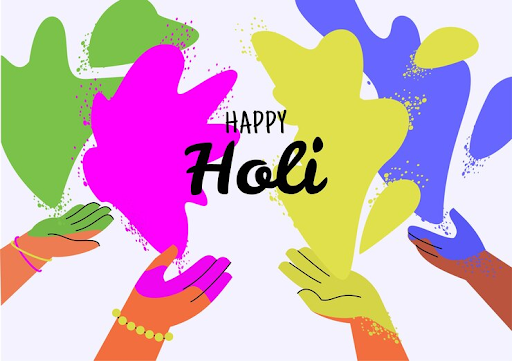
1. Holi is also known as the?
Festival of colours
Festival of fruits
Festival of lights
Answer: Festival of colours
Magha
Baisakh
Phalguna
Pausa
3. The famous ‘Lath maar Holi’ is played at which place?
Barsana
Mathura
Hampi
Answer: Barsana
4. The story behind the Holi Festival is related to:
Radha and Krishna
Demon Holika and Prahlad
None of the above
Answers: Demon Holika and Prahlad
The day after Holi
A day prior to Holi
Same day as Holi
None of the above
6. The bonfire lit during Holi is known as:
Rath Yatra
Holika Dahan
Bari Holi
Answer: Holika Dahan
Rewari and Gajak
Gujihiya and Malpua
Modak and Ladoos
Pongal and Kesari Bat
8. The popular drink prepared during Holi is called:
Thandai
Sharbat
Shikanji
Answer: Thandai
9. Holi is called Phaguwa in which language?
Bengali
Bhojpuri
Sinhalese
Answer: Bhojpuri
Flame of the forest
Bougainvillaea
Lotus
Rose
11. The name of Hiranyakashipu’s sister was?
Holi
Holima
Hidimba
Answer: Holika
12. Which versatile material was used for making pichkaris in the past?
Plastic
Iron
Steel
Answer: Bamboo
13. What are the natural colours used for Holi in the olden days?
Turmeric
Kumkum
Neem
Answer: All of the above
14. Holi marks the end of winter and the beginning of?
Summer
Spring
Autumn
Answer: Spring
15. How long does Holi last for?
1 Day
2 Days
3 Days
Answer: 2 Days
16. What is the demon that was burnt that lead to the Festival Holi?
Malika
Jarika
Heelika
Answer: Holika
17. What are the other names for Holi?
Dhuleti, Dhulandi
Rangawali Holi
All the above
Answer: All the above
Srilanka
China
Nepal
Japan
19. By which name is Holi recognised in Odissa?
Dola Purnima
Dhilhatta
Dolijatta
Answer: Dola Purnima
20. Holi is celebrated in which Hindu month?
Magha
Phalguna
Pausa
Answer: Phalguna


 Users Today : 187
Users Today : 187 Total views : 463888
Total views : 463888